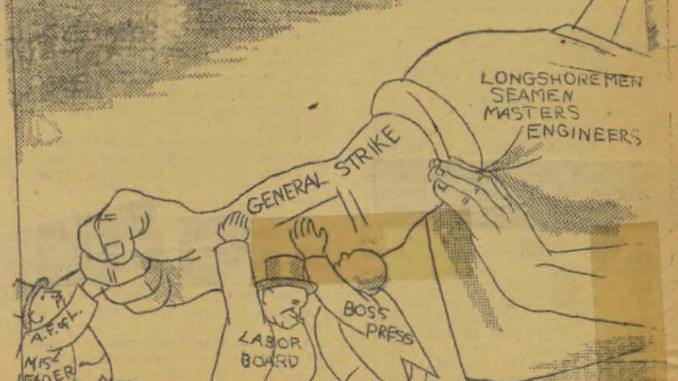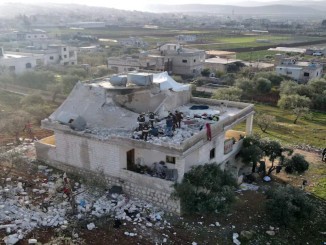
This week, we celebrate the 90th anniversary of the 1934 general strike in San Francisco, when 150,000 workers across the Bay Area shut down the city for four days in a tremendous display of worker power. The strike had begun on May 9 as a West Coast-wide walkout of the International Longshoremen’s Association (ILA). Within the next few days, the seamen and the Teamsters had joined in the strike. It didn’t take long until the mates and pilots, the machinists, boiler workers, shipyard workers, and caulkers had joined in and the entire workforce of the ports were striking together.
As the strike continued, the high-ranking officials of the unions, including the ILA and the Teamsters, worked together to undermine the demands of the majority of the marine workers. The rank-and-file wanted union membership as a precondition for hiring by the employers, a union-controlled hiring hall, protection against unfair firing, higher wages, and a 30-hour work week. The union officialdom was unwilling to fight for these demands. They instead tried to work with the bosses and the mayor to negotiate weak contracts, with separate agreements at each dock. The union officials also ordered the striking workers to limit their pickets to a certain size and frequency, and to temporarily suspend the strike to unload particular ships with cargo deemed too important to block.
However, the workers knew the power was in their hands, not those of the union leadership. A relatively small group of revolutionary workers, some of the most influential of whom were members of the Communist Party, had been organizing on the docks for several years. Due to their dedicated work, including the publication of the Waterfront Worker newsletter, they had managed to harness the widespread anger at the bosses into a large and organized militant workforce.
Facing opposition from the conservative union leadership, the newly class conscious rank-and-file formed Labor Councils and held Strike Conferences that reflected the radical energy of the majority of the workers. On June 12, Waterfront Worker wrote: “Despite the maneuvers of the misleaders, the rank-and-file are going forward and showing the phonies how to conduct a real strike […] The Frisco men show the way by unanimously voting to abide by the majority vote, preserving the unity of the seamen & longshoremen on the Pacific Coast […] SPREAD THE STRIKE. ON TO VICTORY. FORWARD TO A GENERAL STRIKE.”
On July 5, under pressure from the bosses, the police shot at the strikers, killing two men: a longshoreman and a cook who had been volunteering at the strike kitchen. Fury spread rapidly among the working class of San Francisco and on July 16, a general strike was declared. Tens of thousands of additional workers joined in, including bakers, butchers, laundry workers, delivery drivers, culinary workers, cleaners and dyers, boilermakers, construction workers, and more. They set up communal kitchens and democratically decided what services would be allowed to continue to provide for the essential needs of the people of San Francisco. Within a few days, however, the union leadership had wrested back control and brought the general strike to a close. The longshoremen and other marine workers won many of their demands, including control of the hiring hall, reduced working hours, and a substantial raise.
The explosive militant organizing that occurred at the Bay Area docks in the 1930s shows the powerful effect that a small group of committed activists can have when the time is right. Working and oppressed people everywhere today are angry at the bosses, at the politicians, and at the system. Let’s learn from from the San Francisco organizers 90 years ago and work to make sure that anger can be put to use in bringing about a better world.




